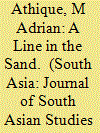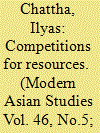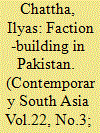|
|
|
Sort Order |
|
|
|
Items / Page
|
|
|
|
|
|
|
| Srl | Item |
| 1 |
ID:
084229


|
|
|
|
|
| Publication |
2008.
|
| Summary/Abstract |
This article examines the visualisation and narrative construction of the India-Pakistan border, and human interactions across that liminal space, as depicted in two films directed by J.P. Dutta, the high-profile, multiple award-winning war film Border (1997) and his subsequent feature Refugee (2000), which was more loosely described in its publicity literature as 'a human story'. 1 Through these films, Dutta established his reputation as the leading Indian director of the 'war film', a genre marked by its relative absence in the Indian cinema prior to the 1990s. Both Border and Refugee thus constitute part of what has retrospectively been described as Dutta's 'war trilogy' (along with the more recent LOC Kargil of 2003, which focuses on the 1999 Himalayan conflict). 2 In the first two films of the set, which I will consider here, the border in question is not the Line-of-Control (LOC) that divides Kashmir, but rather the southern portion of the long border with Pakistan that runs from the southern bank of the Sutlej River across the Thar Desert to the Arabian Sea. Refugee, moreover, is not a war film in the accepted sense, and I will make the argument that it is not so much the martial posturing which constructs the thematic inter-relation of the two films considered here but rather their attempts to naturalise the abstract barrier created by the Radcliffe Line in the west.
|
|
|
|
|
|
|
|
|
|
|
|
|
|
|
|
| 2 |
ID:
118910


|
|
|
|
|
| Publication |
2012.
|
| Summary/Abstract |
This paper explores the part that the redistribution of evacuee property-the property abandoned by departing Hindus and Sikhs during the mass migrations after Partition-played in the institutionalization of corruption in Pakistan. By drawing on hitherto unexplored sources, including Pakistan's Rehabilitation Department papers, local police files and court records, it highlights the schemes of illegal appropriation, misappropriation, and paints a wholly convincing portrait of the scramble for millions of rupees worth of abandoned property in the towns and countryside of West Punjab. It shows how politicians, bureaucrats, powerful local notables and enterprising refugee groups grabbed properties, mainly by bribing officers charged with allocating them to incoming refugees, or by utilizing their personal contacts. The paper argues that the fierce competition for resources and temptations for evacuee property encouraged the emergence of a 'corruption' discourse which not only contributed to an atmosphere that was detrimental to democratic consolidation in the early years of Pakistan's history, but also justified later military intervention. This not only adds to the empirical knowledge of Partition and its legacies, but also makes a significant contribution towards our understanding of the transitional state in Pakistan.
|
|
|
|
|
|
|
|
|
|
|
|
|
|
|
|
| 3 |
ID:
133096


|
|
|
|
|
| Publication |
2014.
|
| Summary/Abstract |
This essay provides new evidence on local Pakistani politics in the immediate post-independence period. It reveals that far from being a period of national unity and service to the fledgling state, the country was mired in faction-building strategies between political rivals, competing for power and scrambling for resources, with debilitating consequences for democratic consolidation. While the new sources - largely based upon the archival records deposited at the National Documentation Centre, Islamabad - provide material relating primarily to Punjab, this essay demonstrates that the tensions between central government and the provinces can only be comprehended by reference to studies of localities.
|
|
|
|
|
|
|
|
|
|
|
|
|
|
|
|
|
|
|
|
|